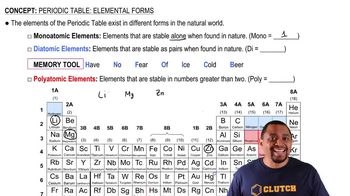Ch.22 - The Main Group Elements
Chapter 22, Problem 36
Which element in each of the following pairs has the higher electronegativity? (a) Sb or I (b) P or Sb
 Verified step by step guidance
Verified step by step guidance1
Step 1: Understand the concept of electronegativity. Electronegativity is the ability of an atom to attract electrons towards itself in a chemical bond. It generally increases across a period from left to right and decreases down a group in the periodic table.
Step 2: Locate the elements on the periodic table. For part (a), find antimony (Sb) and iodine (I). For part (b), find phosphorus (P) and antimony (Sb).
Step 3: Compare the positions of the elements in each pair. Iodine (I) is to the right of antimony (Sb) in the same period, and phosphorus (P) is above antimony (Sb) in the same group.
Step 4: Apply the trend of electronegativity. Since electronegativity increases across a period, iodine (I) will have a higher electronegativity than antimony (Sb). Since electronegativity decreases down a group, phosphorus (P) will have a higher electronegativity than antimony (Sb).
Step 5: Conclude the comparison. For part (a), iodine (I) has higher electronegativity than antimony (Sb). For part (b), phosphorus (P) has higher electronegativity than antimony (Sb).
Key Concepts
Here are the essential concepts you must grasp in order to answer the question correctly.
Electronegativity
Electronegativity is a measure of an atom's ability to attract and hold onto electrons when it forms a chemical bond. It is a dimensionless quantity typically measured on the Pauling scale, where higher values indicate a stronger attraction for electrons. Understanding electronegativity is crucial for predicting bond types and molecular behavior.
Recommended video:
Guided course

Electronegativity Trends
Periodic Trends
Periodic trends refer to the predictable patterns observed in the properties of elements across the periodic table. Electronegativity generally increases from left to right across a period and decreases from top to bottom within a group. Recognizing these trends helps in comparing the electronegativity of different elements.
Recommended video:
Guided course

Periodic Trends
Comparison of Elements
When comparing the electronegativity of two elements, it is essential to refer to established values or trends. For example, iodine (I) is more electronegative than antimony (Sb), while phosphorus (P) is more electronegative than antimony. This comparison is vital for determining which element in a pair has a higher tendency to attract electrons.
Recommended video:
Guided course

Elemental Forms of Elements
Related Practice
